Vanilla ice cream (again)
Ah – vanilla! When prepared in an authentic way (with no cheap substitutes), vanilla ice cream can be absolutely delicious already on its own. But vanilla also tend to go well with a myriade of other desserts, and just about everything you might want to put in your ice cream – No wonder that vanilla reigns unchallenged as the world’s most popular ice cream flavour!
From South America with love …
The history of vanilla is as fascinating as the flavour is delicate, and those interested should really check out this post, covering both the romantic fairy tale-like origins in South America, the Spanish role in vanilla’s later world-wide success and the present situation.
It has been said that every ice cream maker should have his or her own favourite vanilla ice cream recipe. That may be true, but I find it equally fun to try different ones: after all, it would be a shame to miss a really good one just because you have convinced yourself that you already have one you like 😉 .
Today’s recipe is adapted from one by talented ice cream chef Ben Vear, and is definitely worth checking out (as is his book!).
Basically, it is a custard-based ice cream, prepared with about equal parts milk and cream and a not too excessive amount of eggs. In other words, it falls somewhere inbetween the typical French and Italian classic custard recipes. In order to ensure an even fresher overall taste, I have added a little yoghurt towards the end – this works really well for all of us who like our ice cream flavours less “overwhelmingly creamy”.
In order to ensure a nice consistency, the recipe also contains a ‘structural’ ingredient which some purists may frown upon – skimmed milk powder. However, as you will see, the amount used is fairly small and the nice results clearly justifies it, IMHO. What the skimmed milk powder does, to put it plainly, is that it helps to absorb some of the liquid that otherwise could turn into nasty, large ice crystals – the sort of crystals rightly feared by all ice cream lovers (technically speaking, the powder adds to the proportion of the ice cream’s non-fat solids).
Looking to boost the vanilla flavour even further?
The original recipe called for the use of (genuine) vanilla extract, and this is also what I went with here. Using good quality vanilla extract works very well. However, feel free to use a real vanilla bean if you like – that works as well, and possibly even better [split the bean, then add both the bean and its seed content into the milk. Just don’t forget to remove the bean-parts before churing the ice cream, though].
Another way to boost the vanilla flavour is to use vanilla sugar instead of ordinary sugar (or at least let vanilla sugar form part of the total amount of the sugar).
This does not even need to cost you more than a little planning, as you will be able to get vanilla sugar by adding a vanilla bean to ordinary white sugar and churn it all in a food processor or its like. Store in a (closed) jar until it is time to use it. And while you may use a “fresh” vanilla bean + seeds for this, you may as well use the (dried) sheaths of a ‘used’ vanilla bean – they will still be sufficiently aromatic to do the trick!
First – prepare the custard base!
While many of you surely know the drill, I will go through the steps anyway.
Start by whisking the egg yolks with half of the (possibly, vanilla)sugar. Set aside for now.
Now, mix the cream and the milk together with the vanilla extract (or vanilla bean, if using) and the other half of the (vanilla)sugar.
Bring to a simmering almost-boil, continue to whisk every now and then for about about 4-5 minutes, also adding the skimmed milk powder. Make sure that it does not boil.
Now, slowly and little by little, begin to whisk in the hot milk-part into the egg yolk-sugar mixture. This can be a bit delicate, as you definitely want to avoid the egg yolks turning into scrambled eggs.
Just ensure that the milk is hot, but not boiling hot, and whisk all the time. If you do this, and avoid mixing everything in at the same time, you should be OK.
Conservative or modernist? – A quick reflexion on how best to prepare ice cream custard bases
Here, we have obviously been using the ‘Traditionalist approach’ to preparing custard bases. Iconoclasters and kitchen realists may well try the less time-consuming, more modern, method of simply adding all ingredients mentioned (eggs, sugar, milk, cream, vanilla) in a saucepan already from the start and begin the cooking from there. Just remember to only add the yoghurt once the base has cooled down!
In my experience, both methods work well but out of respect for Ben Vear, I stick with the traditional method in this post.
Once the whole base has been mixed together, it is time to bring the custard to the required cooking temperature (= sufficiently hot to pasteurise it, but not so hot that the egg begin to coagulate).
This can be done in several ways but you should be fine with just a good saucepan, a whisk and a thermometer. Since the so-called nappe stage (when the custard has both thickened and been sufficiently pasteurised) is dependent on the temperature, I strongly recommend the use of a thermometer.
When the custard has been brought up to about 82-84º Celsius (180-183 ºF), it should be ready. If you lack a thermometer, use well-known rules of thumb such as the so-called Spoon-test, or the Rose-test.
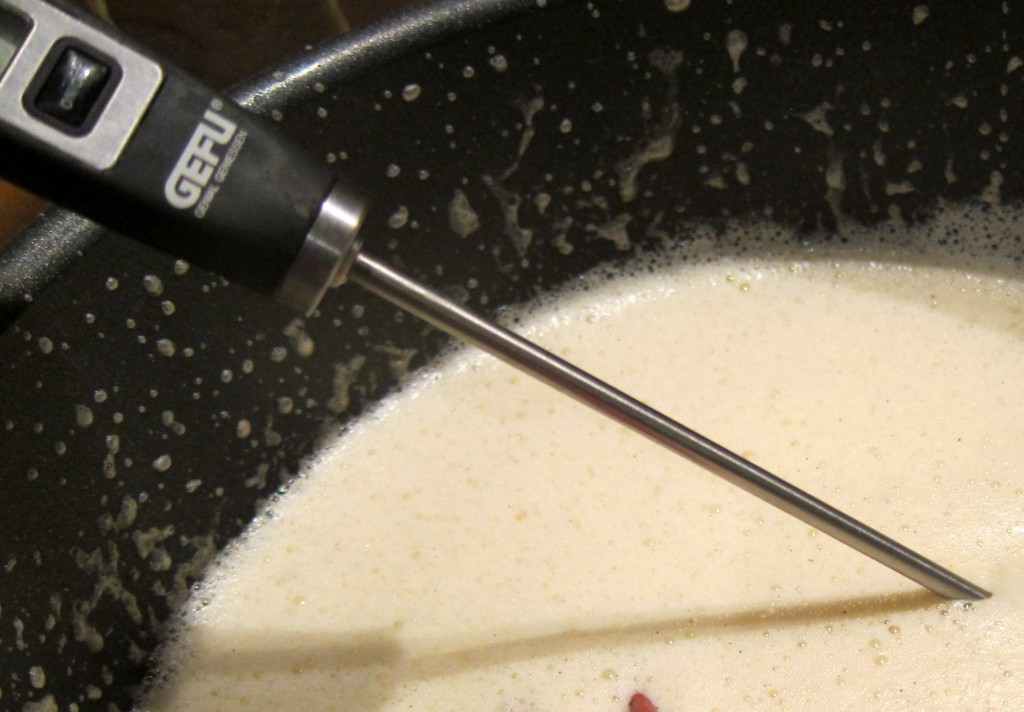
Cooking the base improves the consistency of the final ice cream, but the temperature requirements set out are also there to ensure that the base is appropriately pasteurised!
Once sufficiently cooked, cool down the ice cream base as fast as you can: letting it rest in a bowl floating in ice-cold water is one way. When sufficiently cool, add the yoghurt [if using] to the base and put it all into the refrigerator, preferably over the night.
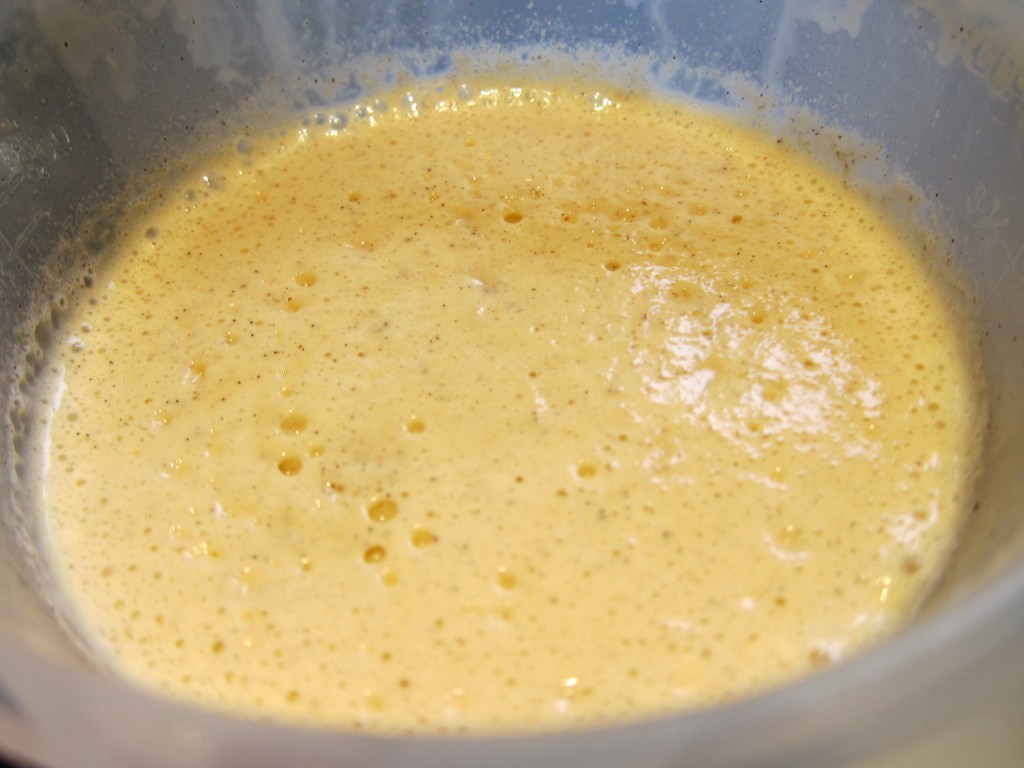
The ice cream base, ready and chilled, waiting to be churned. Notice the markedly thickened consistency.
It may be debatable how much ice cream custard bases really gain in flavour by “resting/maturing” before churing. But regardless of this, the final ice cream will clearly be better the colder the base is at the time of the churning. If only for this reason, letting the base spend a few hours in the refrigerator before churning remains a very good idea.
And as usual – if you have no ice cream machine, go ahead and still-freeze your ice cream using your freezer! Go here for some practical advise on that method.
In conclusion: A very nice vanilla!
Those who have tried genuine vanilla ice cream know that is can be a truly delicious flavour. And this recipe truly delivers! The distinct vanilla flavour is round and full, leaving nothing further to be desired. Also the overall consistency of the ice cream remains nice, despite the (relatively speaking) limited amount of milk fats and egg yolks – no doubt partly thanks to the skimmed milk powder.
Everyone needs a good vanilla ice cream recipe, and in my view, this one has the potential to be one of those trusty “go to” recipes: this is a very good vanilla base recipe! Whether you plan on enjoying the delicate vanilla flavour on its own or combine it with something else, your tastebuds will thank you!
- 250 ml (1 cup) cream
- 200 ml (0.85 cup) milk
- 50 ml (about ¼ cup) yoghurt (Turkish or Greek dense type, about 10 % fat)
- 125 gram sugar (all or part of it vanilla sugar)
- 1 teaspoon good quality vanilla extract
- 5 egg yolks
- 2 tablespoons skimmed milk powder
- Pour milk, cream, the vanilla extract and ½ of the sugar in a saucepan. Whisking every now and then, bring to a simmering almost-boil for about 4-5 minutes, then set aside.
- In a separate bowl, whisk together the egg yolks and the other half of the sugar.
- Little by little and while whisking constantly, stir in the heated dairy mixture into the whisked egg yolks.
- Once combined, pour this base into a saucepan, put on heat and - while whisking - add the skimmed milk powder and carefully bring the base to the nappe-stage = 82-84º Celsius (180-183 ºF). Use of a thermometer is recommended!
- Take off from the heat and let cool down as quickly as possible. Then, whisk in the yoghurt.
- Put in the refrigerator to chill over the night.
- Then churn the ice cream base in your ice cream maker. If you do not have any, still-freeze it using your freezer.
- Once finished, enjoy fresh or store in a freezer-safe container: cover with plastic film and a lid.
***
For useful advise on how to still-freeze ice cream without an ice cream machine, go here: http://www.icecreamnation.org/freezer-only-make/
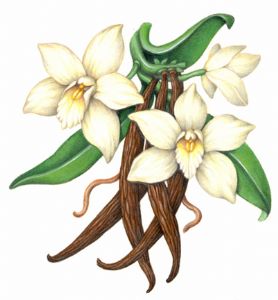
![tahitian-vanilla-beans[1]](http://www.icecreamnation.org/wp-content/uploads/2014/11/tahitian-vanilla-beans1.jpg)
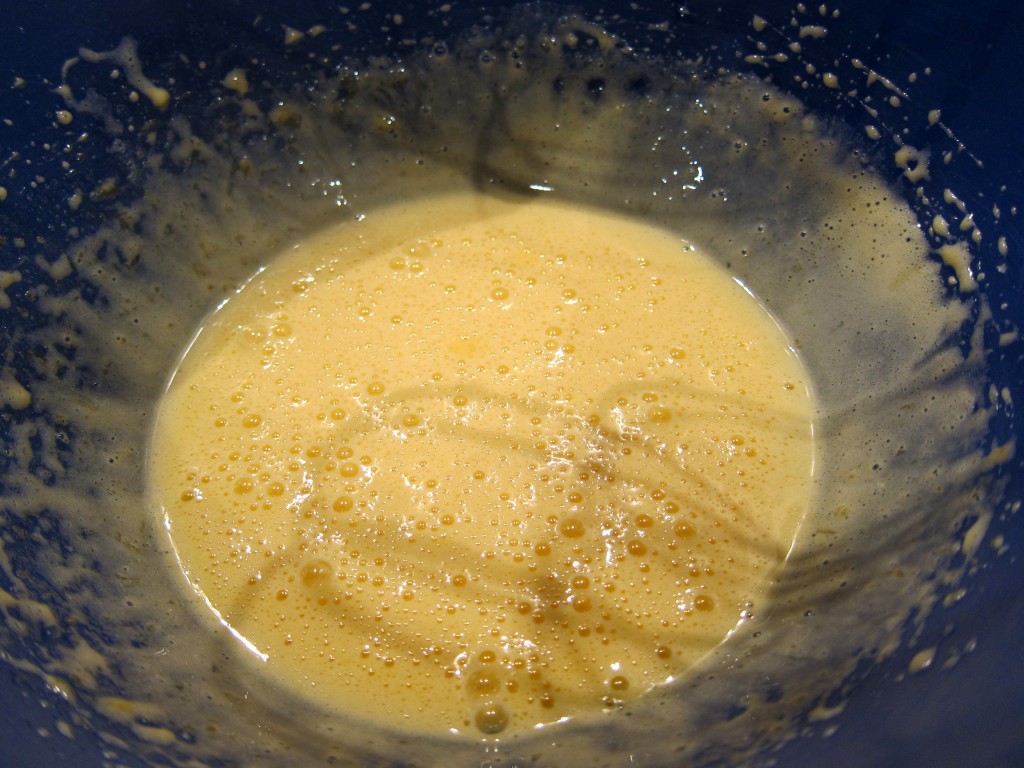
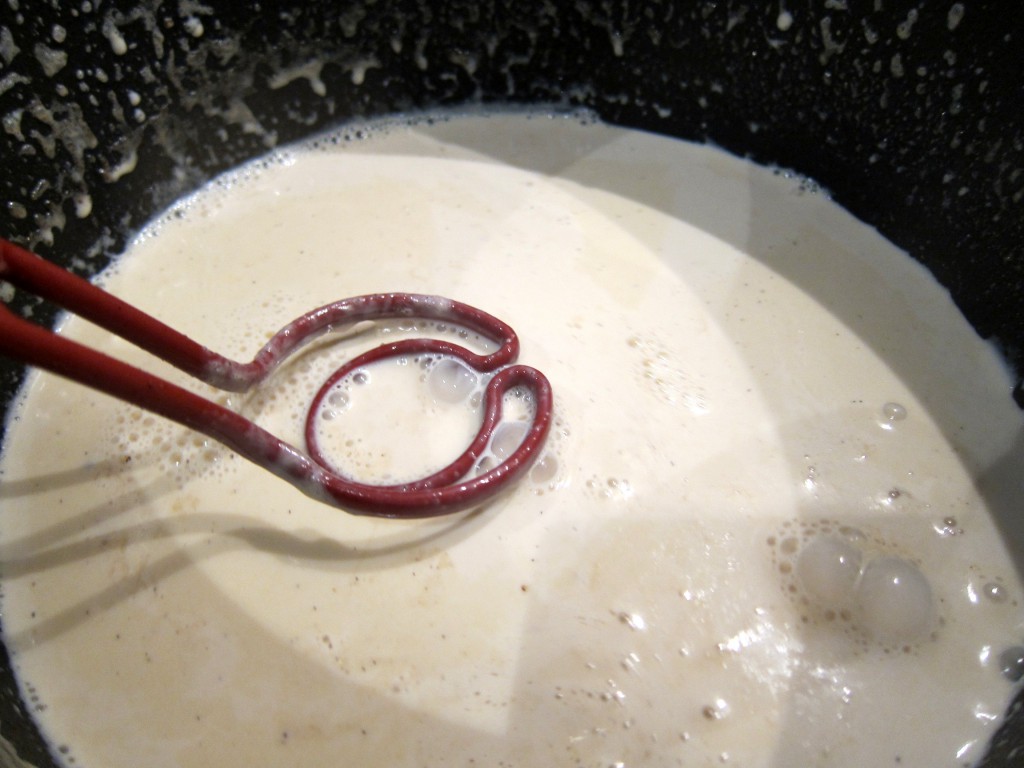
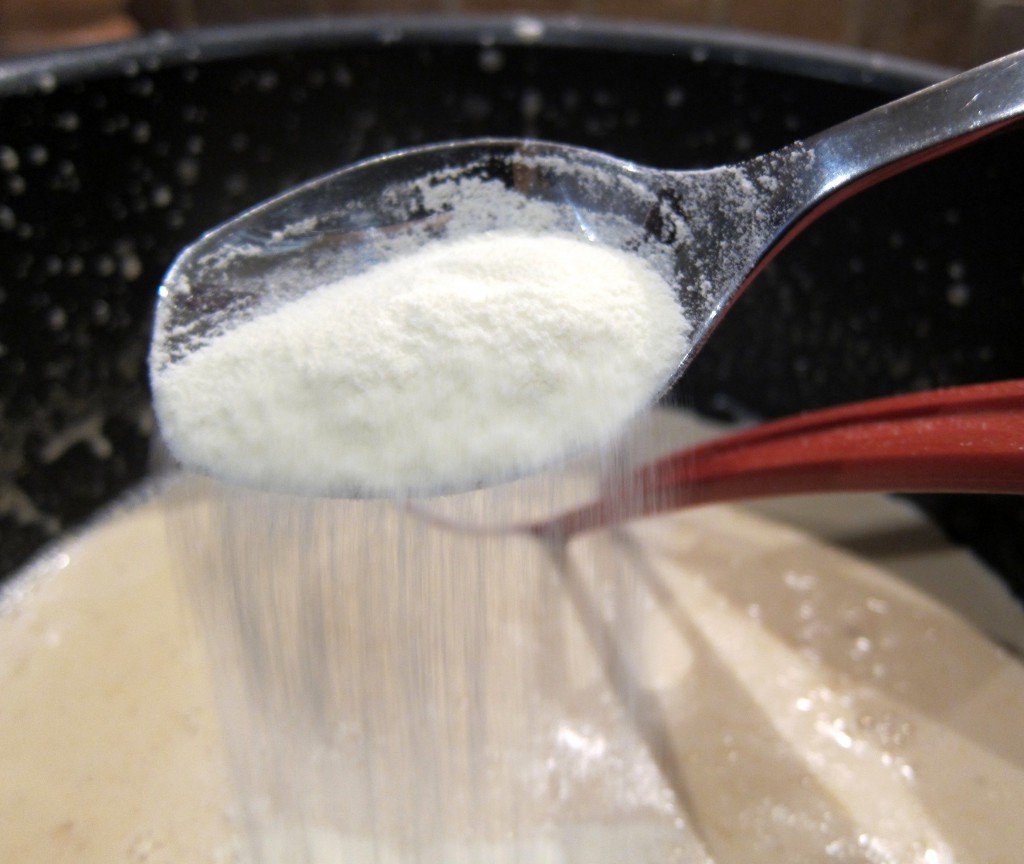
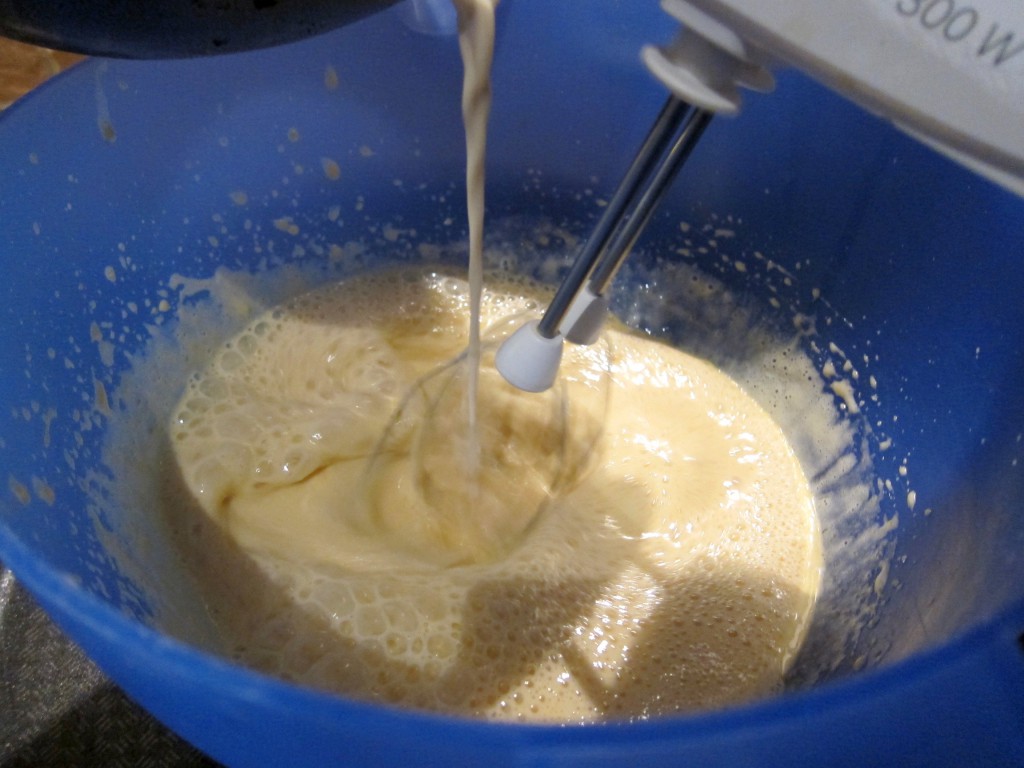
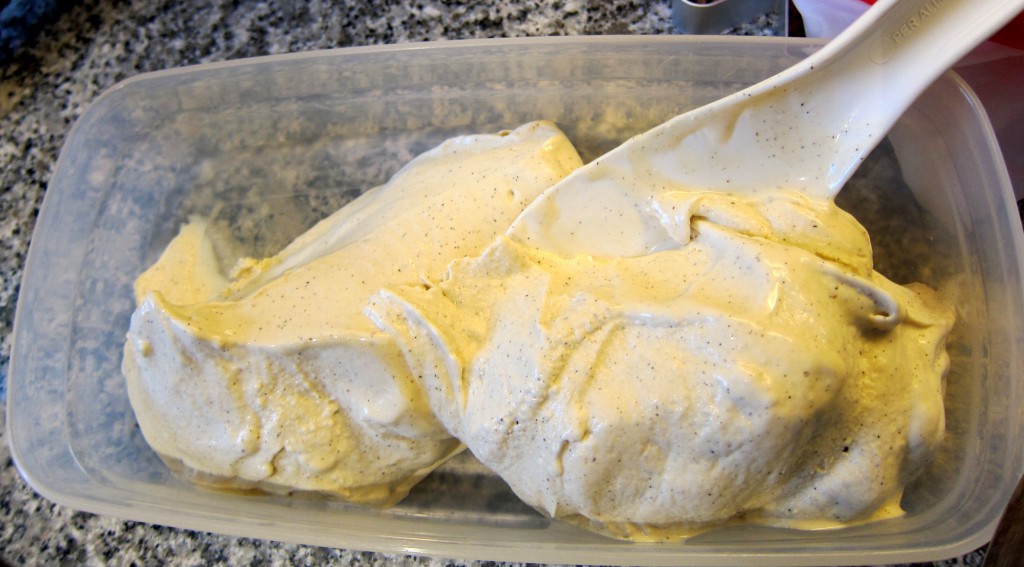
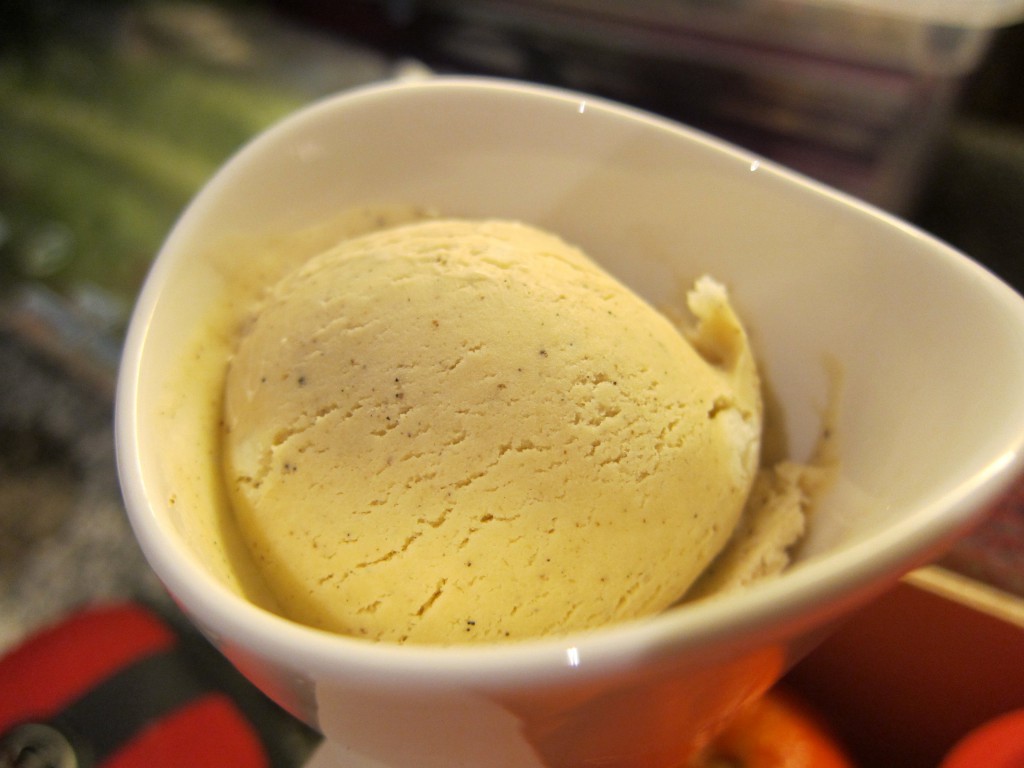
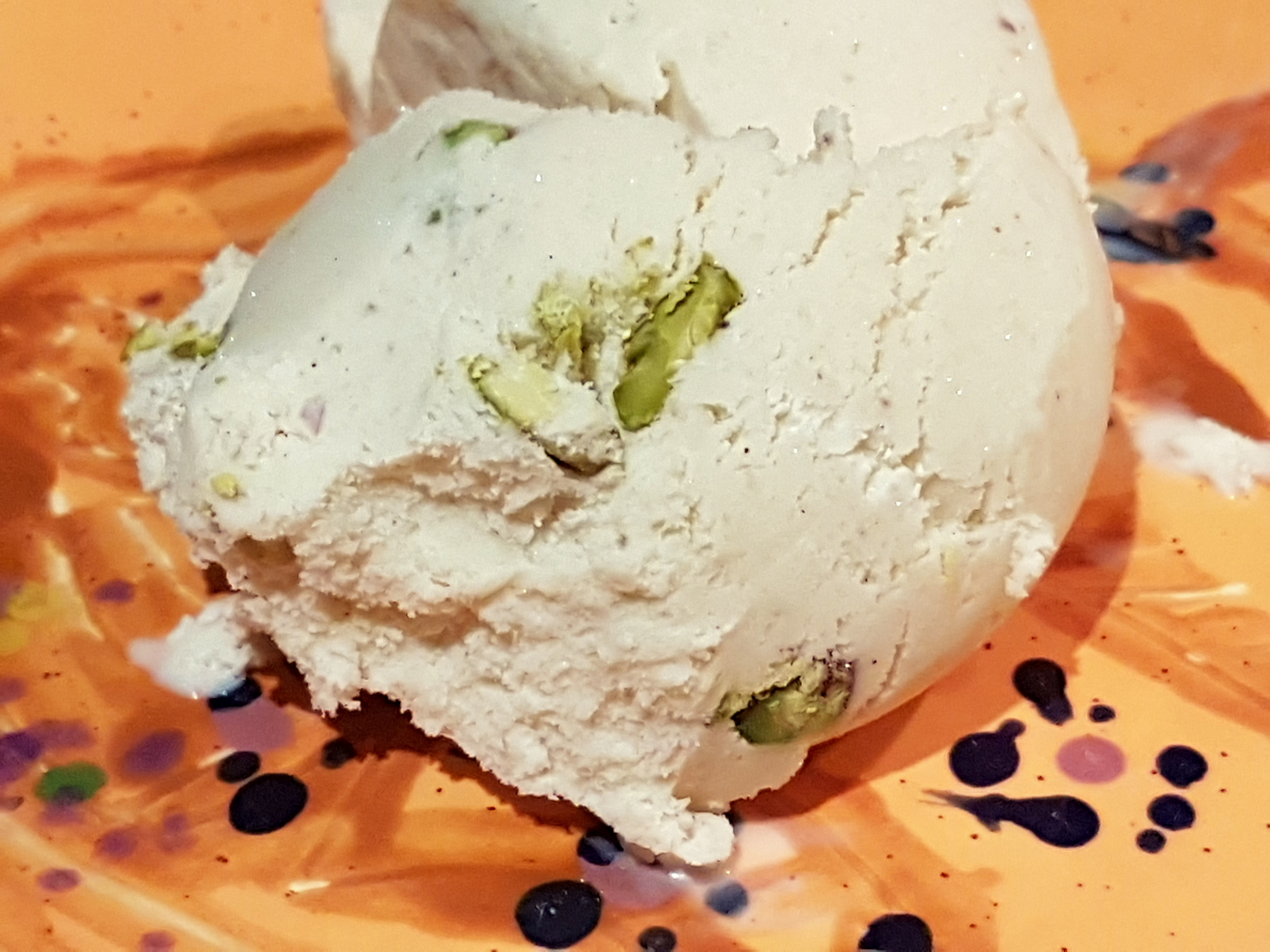
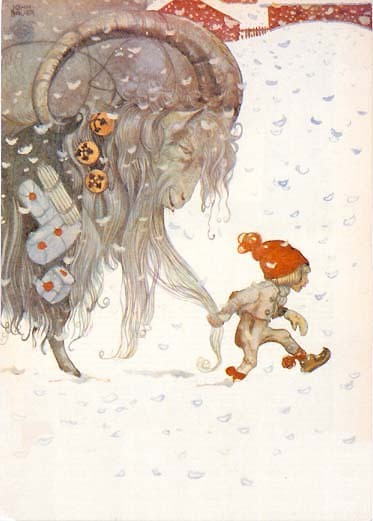
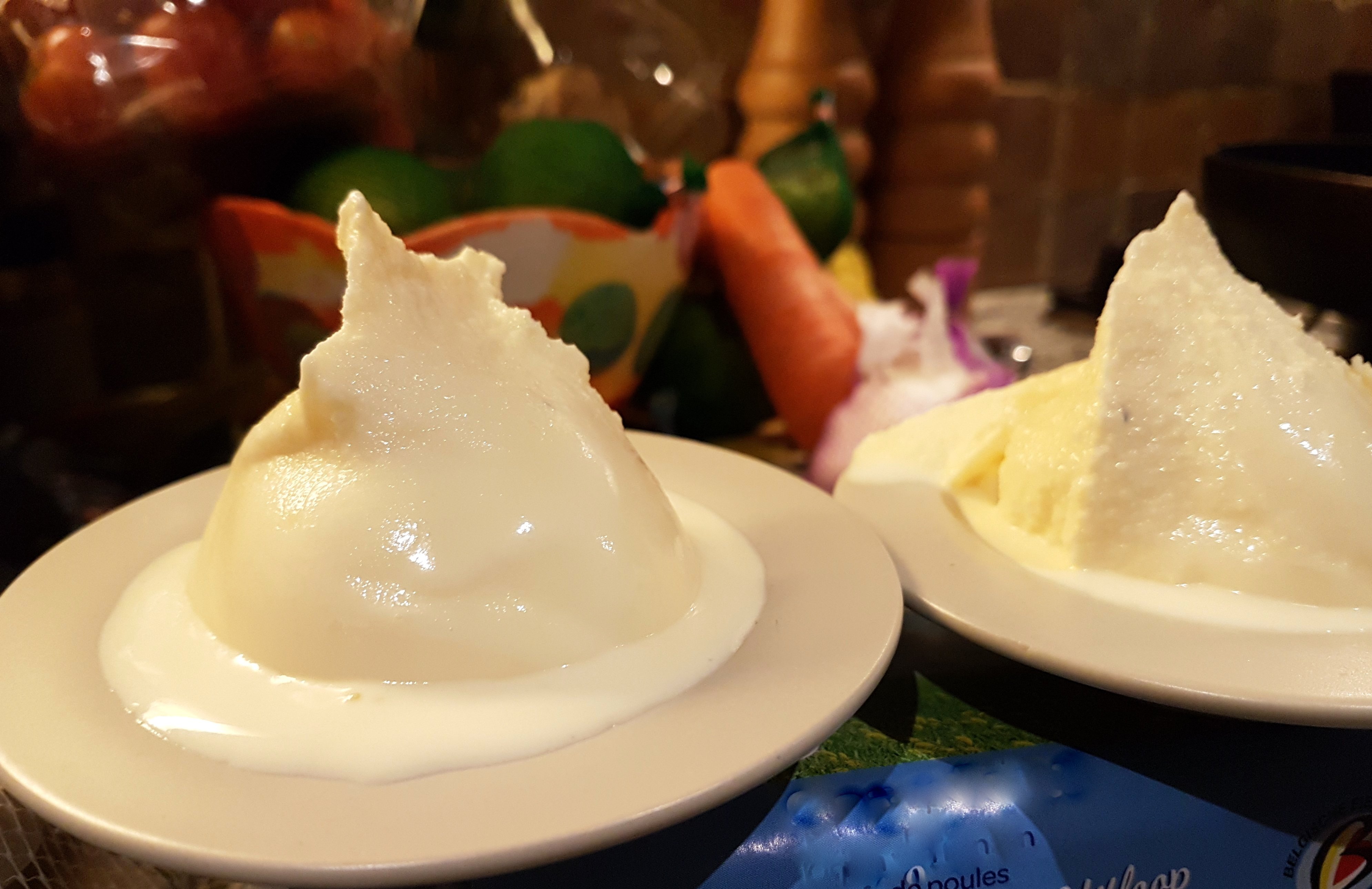


HI MR Anders ,
my father want to open an ice cream shop and he have a problem in his delaram machine ,, its over beating if good to say ..
i think this affect the texture of ice cream ..
please sir do you know how we can solve this??..
Hi Anders,
thank you for the recipe I will try i today. But how much ice cream come out of this recipe?
Hi Morris,
You would end up with, roughly, about 650 ml (2 3/4 cups) – it depends a bit on how much air (“overrun“) your ice cream machine manages to mix into the ice cream.
If you need more, just adapt the recipe 🙂
hi
about skim milk in this recipe when u add it it doesn;t show
i will try it from calculation it seem good
Hi Franciss,
You should add it while heating the base (and thanks for spotting that this piece of info was missing in the recipe (now duly corrected)!
Thanks, Anders, for the great recipe. I have 2 questions. First, simple one, how much will it yield, approx. 500ml or 2 quarts of ice cream base, if my math is correct? Second, do I have to add guargum? I have tried different variations at home using a rented dewar of liquid nitrogen LN2 (believe me, it’s fun!) but the results have been quite unsatisfactory in texture although no one could fault the taste. The ice cream I made was runny and even after I increased the amount of LN2, it firmed up but then melted too fast, back to runny again right after scooping from the mixing bowl! Please help!
Hi Quan,
The recipe should yield about 650 ml (2 3/4 cups), mainly depending on how much air (“overrun“) your ice cream machine manages to mix into the ice cream base.
As to the texture, you should not need any guargum as the egg yolks and the milk solids should be sufficient. But since you do the freezing with liquid nitrogen (and yes – it does sound like great fun!) I would suspect that it still might be that you simply need to let the liquid nitrogen ‘work the ice cream’ longer: Even if some initial freezing may go fairly quickly, more liquid nitrogen will be required to bring about a more lasting effect (as far as ice creams now go). The rule of thumb I’ve heard is that it would take about one litre of liquid nitrogen to properly freeze one litre of ice cream …
Hi Anders,
Thanks for quick reply! I guess I can get 5 servings out of this. Regarding LN2, I don’t know. I poured in up to 1.2 – 1.5 LN2 to ice cream ratio, and the ice cream is nice and firm, but as soon as I tried to scoop it out, it starts getting runny. I even tried to chilled the bowl, but the result was still not far from satisfactory. BTW, I am playing around with different recipe for ice cream bases for my small shop 🙂 At this rate, it’s acceptable but not great! Thanks again for coming to my rescue
Hi Anders !
May I know what is the priciple of using Youghurt in this recipe? Does is act as a stabilizer ?
Hi!
The yoghurt, with its tangy taste, adds a pleasant freshness to the overall flavour.
Hi,
You specify cream in the recipe. Is there a particular type of cream? Will ordinary whipping cream be sufficient? I’ve gone through a lot of recipes and they mostly ask for heavy cream but can i substitute with ordinary whipping cream for heavy or double cream?
Hi Stt,
There are no international labelling standards for cream, so what really matters is the fat content. The recipes on this site should generally work well with cream with – at least – a fat content of about 35 % (= UK “whipping cream”).
Hi Anders,
I have anothet question! (I’ll admit it first.. i h avent tried your method yet) but some other base recipes calls for you to whip the cream first then fold in the cooled base mixture (so i assume this method introduces more air i to the ice cream?). However i realise that one the ice cream is ready to be eaten, a rough layer sticks to the spoon (almost like fat residue from the cream?) Unlike the shop ice creams where your spoon is clean after u eat the ice cream. Do you know why my home made ice creams have this residue stuck to the spoon? Could it be in the method of making the base? The whip cream i use is no less than 35% fat.
Thanks!
Hi again Stt,
I’m not sure about that layer, but it sure sounds like some kind of fat residue.
Whipping the cream before folding it into the base can be done (and you are probably correct in assuming that the whole point is to introduce more air into the ice cream: this might have some value when still-freezing ice cream, but I see little point in doing it if the churning is done in an ice cream machine) but I would guess that this might affect the way the fat is distributed within the base (= clogging together, rather than dispersing in a “finer” way). If the layer bothers you, I would suggest to skip the whipped cream-approach and see if using liquid cream comes out better. Also, you might reflect on how much cream/fat the recipes you’re using contain.